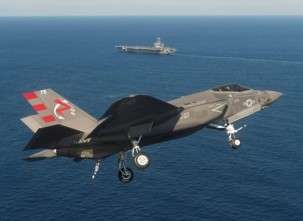A F-35C stealth fighter, similar to one linked to sonic booms off New York, New Jersey and Connecticut. Its top speed is said to be 1,200 miles per hour. Credit: Lockheed Martin
The East Coast boom issue dates to at least the winter of 1977-78, when similar shock waves hit many communities. The military denied responsibility, so rumors and speculations abounded: secret weapons tests; operations of spacecraft or submarines; giant methane bubbles erupting from the seafloor. Lamont seismologists hypothesized that small earthquakes were emanating from areas lacking adequate instrumentation; or oil companies might be igniting explosives offshore to explore for petroleum reserves. David Simpson, then Lamont's head of seismology, set out an array of portable seismometers near Cape May, N.J., where many complaints came from, but got little useful information. "This was a big mystery that lasted for months," said Lamont seismologist emeritus John Armbruster. "It shows the frustrations of dealing with a culture of military secrecy."
Members of Congress, alarmed about the repeated episodes, demanded an investigation from then president Jimmy Carter, and Carter turned it over to the Office of Naval Research. Carter's science advisor was a Lamont alumnus: the influential seismologist and oceanographer Frank Press. Press might have had something to do with the eventual resolution. In any case, after months of research, the government finally issued a report admitting that its own jets were to blame.
That has not stopped people from being scared by the booms; earthquake alarms linked to them are still a regular event (though the extent of the more recent ones may be due as much to the ubiquity and instantaneous nature of social media as to the weather or the actual number of flights). From Maryland to New Jersey, a series of booms sparked concern along the coast in October 2012, and again in February 2014. Two days before the most recent event, residents of Charleston, S.C., were also frightened by tremors. At least in these events, the military has been quick to step up and take responsibility.
Because the shock waves travel through the air, not the ground, conventional seismic instruments don't generally pick them up–that is, unless they strike hard enough to cause buildings or ground to shake. Even then, the motion might not be picked up unless there happens to be an instrument close by, because compared to a real earthquake, the effects are relatively weak and local.
That said, the latest booms were relatively powerful. Kim says he measured eight. A conventional seismometer near the southern New Jersey town of Hammonton registered a series of ground vibrations. The Lamont lab is still analyzing data, but other seismometers in New Jersey and Long Island may also have picked up ground motion.
A new set of seismic stations installed since 2013 also have air-pressure sensors, and detectors for infrasound, which can clearly detect sonic booms (along with hopefully less common events such as nuclear bomb tests or large meteors streaking through the air). At Hammonton and at least five other stations in New Jersey and Connecticut, infrasound detectors picked up acoustic waves. An air-pressure sensor at Hammonton also jumped at the same time. "Some things, we don't hear, but they still have energy," said Kim.
Provided by Columbia University






















